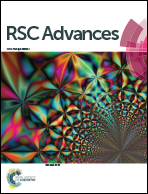Normal and reverse base pairing of Iz and Oz lesions in DNA: structural implications for mutagenesis†
Abstract
Although G:C to C:G mutations are known to be crucial in some key tumor genes, the exact mechanisms of these mutations are not known. Herein, we have used a density functional theoretical approach to investigate the mechanisms of G:C to C:G mutations induced by 2,5-diamino-4H-imidazol-4-one (Iz), and its hydrolysed product 2,2,4-triamino-5(2H)-oxazolone (Oz) formed due to oxidative degradation of guanine (G) and 8-oxoguanine (8-oxoG). Structures, binding energies and electronic properties of different base pair complexes involving the most stable tautomers of Iz and Oz were studied in detail by considering the nucleobase and nucleoside models. It is shown that the most stable keto tautomer of anti-Iz makes the most stable base pair complex with G by adopting a reverse base pairing orientation. It is further found that the most stable keto tautomer of anti-Oz favors insertion of G opposite it and the resulting base pair complex is stabilized by both the normal and reverse base pairing orientations. As the reverse base pairing structures would be difficult to occur in physiological DNA, it may be proposed that the insertion of G opposite normal Oz may be mainly responsible for the observed G to C mutations in DNA. The results obtained in the present study can be helpful for further structural studies on Iz and Oz lesions in DNA in presence of different DNA polymerases to unravel the mechanisms of G to C mutations observed in carcinogenic genes.


 Please wait while we load your content...
Please wait while we load your content...